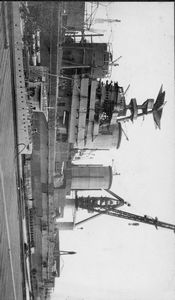Catalogue number 120003a
Hood in the fitting out basin, 1
H.M.S. Hood was launched on 22nd August 1918 by Lady Hood and in this photograph the ship is shown at the fitting-out basin of the John Brown & Co Ltd Clydebank shipyard, April 1919. In the foreground is the aft part of a Modified W class destroyer with the triple aft torpedo tubes in place but no quarter deck guns mounted. The armour plate of Hood’s conning tower has been fixed in place and work is underway on the bridge structure. Only four of the six port 5.5-inch guns are in place and not all of them have gun shields - the open splinter shields, leaving the crews very exposed, were a weak point in the design. The aftermost 5.5-inch gun was subsequently removed during construction. There are two sets of two doors in the hull to port, one set aft of the second funnel and a second set at the level of the main mast. When completed, H.M.S. Hood had four above-water torpedo tubes, two to port, two to starboard. However, the final legend of 20th August 1917 mentions eight above-water tubes (British Battleships 1919-1939, R.A. Burt, 1993). Furthermore, in “The Battlecruiser HMS Hood: An Illustrated Biography 1916-1941” by B. Taylor (2005), page 13, it is stated that four of the eight above-water torpedo tubes were removed and the hull opening plated over in May and June 1919 when construction was well advanced. The plating over the torpedo bulges is almost complete. The foremast with starfish is yet to receive the control top although the torpedo and searchlight platforms have already been fitted.
Recto: “H.M.S. “Hood” building at Clydebank April 1919” in white ink
12.8cm x 7.5cm Gelatin silver print
|
 |